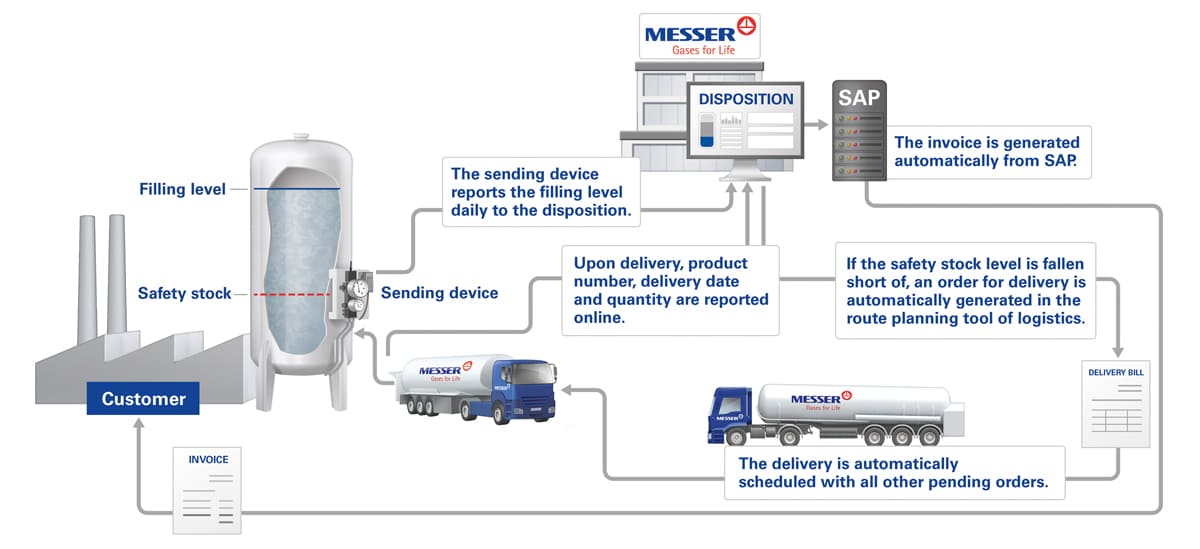By: Editorial Team Reading time: 3 Minutes
◤ DIGITALIZATION
Industry 4.0 in Messer’s supply chain
The hype has subsided, but it continues to make progress behind the scenes: the path to Industry 4.0 and the Internet of Things (IoT) is gradually coming to fruition. At Messer, for example, with semi-automated customer deliveries and a communicative ERP system.
In the gases business, plants and processes have always been interwoven between customers and suppliers. Many customers with a sufficiently large demand for gases lease the storage tanks that Messer installs at the customer’s locations. Those tanks are equipped with level transmitters and a SIM card: once per day, the current tank level is automatically transmitted to Messer over the mobile phone network. Logistics uses the level data history to track the customer’s consumption profile, which can be evaluated to optimize supply. If the level in the tank falls below the minimum quantity specified by the customer, the route planning system automatically schedules the customer’s next delivery.
❝
But we are most efficient when the automated system supplies as many customers as possible.
Markus Renner, who is in charge of this system in Messer's logistics department
Automated delivery routes
The dispatcher in charge then organizes the delivery for the next day using software designed to optimize route planning. The semi-tractor trailer drives to the various customers along the shortest possible route and with the most effective distribution of transported gases possible. “In our supply chain, we always have a certain amount of flexibility to handle exceptional situations – like when an extra shift consumes an unusually large quantity of gas and immediate resupply is needed,” emphasizes Markus Renner, who takes care of this system in Messer’s logistics. “But we are most efficient when the automated system supplies as many customers as possible.” Connections at the two ends of the process are even more direct and fully automated with on-site units where the gases flow to the customer via pipeline. Production there follows the actual quantities consumed practically minute by minute. How that works is described in detail in the cover story of this issue.
When delivering products to customers by tank truck, the transferred quantity is recorded automatically by a calibrated instrument on the vehicle and can be transmitted to the route planning program and SAP by scanning a barcode. Delivery note and invoice are then issued automatically. The delivery of gas cylinders works in a very similar way. Each cylinder carries an individual barcode that is scanned during all relevant movements. The system tracks several parameters, including the latest fill level, the current location, and the next regularly scheduled inspection date.
❝
We are currently experimenting with artificial intelligence to automatically evaluate accounting-related e-mails.
Marc Dierckx, who manages the online store and is involved in the introduction of AI applications
Online overview
Delivery notes and invoices can be issued automatically here, too. The customer receives them by mail or can call them up on a web portal. “In the portal, the customer can also place orders directly and obtain a complete overview of deliveries, inventory and consumption online,” explains Marc Dierckx, who manages the Online Shop and takes care of introducing AI applications. “We are currently experimenting with artificial intelligence to automatically evaluate accounting-related e-mails. In the future, this will also permit companies that receive small purchase volumes to be integrated into networked processes as
well.” For companies that regularly purchase very large quantities, Messer already relies on an ERP connector. These connections between two ERP systems are individually programmed. The systems then maintain a fully automated exchange of information with one another relative to orders, deliveries, and invoicing. “This eliminates countless manual procedures – along with any associated transmission errors,” adds Marc Dierckx. “We take a pragmatic approach to integrating the procedures and make certain that both sides always benefit.”

